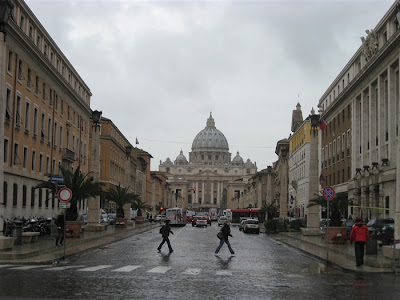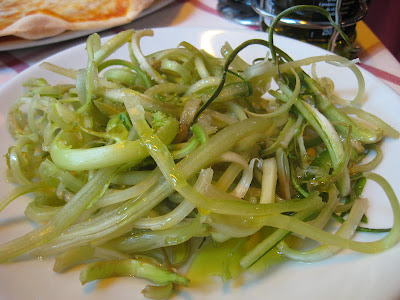This is my foodie tour of Rome, and it's going to be one mega-long post.
After our holiday in Sweden, Jonas and I spent one week in Rome. As expected, it was a food paradise and we enjoyed so many local specialities.
The trip was further enriched by the sense of nostalgia I felt walking through the city again.
Ten years ago I lived in Rome as a nanny for a wonderful Italian family (Paola and her kids Jacopo & Ludovica, collectively named PaJaLu). Now those kids are 23 and 21 yrs old (!!!) and I’m an old married lady. Times have changed but after spending time together again, I realised we get on just as well as we did when we lived together. Paola is just like a second mother “mia mamma italiana” and i ragazzi are like my little brother and sister. It was so nice to be with them again.
So both the touristing and the family moments on this trip were rich and exciting and nostalgic. And of course the food just rocked.
Speaking Italian again for the first time in years was pretty fun too, and after two weeks in Sweden I was surprised how easily I switched from Swedish to Italian, and how much Italian I remembered without realising it!
But now onto the food . . . .
Porchetta is a Roman specialty made from a hog roasted on a spit with herbs and wild fennel. The man who prepares the porchetta is known as a porchettaro, and I was lucky enough to meet one at PaJaLu’s local supermarket as he carved up the meat. I chatted to him for a while and he was so proud that I photographed him at his work. I was just as honoured to eat the delicious results at lunch!
Can you imagine anything more wonderful than a mozzarella bar? There are two in Rome, part of a chain of nine locations including London, New York and Tokyo. Obiká provides a range of Mozzarella di Bufala Campana (a DOP cheese made of buffalo milk) and Jonas and I made sure we tried all four:
Paestum (delicate taste)
Pontina (stronger taste)
Affumicata (smoked)
Stracciatella di Burrata (sweet and creamy taste)
The stracciatella di burrata was my absolute favourite, with strings of delicious cheese in an oozing cream infused mass. Burrata is one of the most wonderful cheese experiences you can have.
 |
| The Colosseum |
Carciofi alla Giudia translates to Jewish-Style Artichokes, and in the Roman context this means deep fried so the edges are crisp and crunchy while the interior and heart are still wonderfully soft.
 |
| A square in the Jewish Ghetto |
Stracetti con Rughetta is a typical Roman dish consisting of fine strips of veal, sautéed then topped with fresh rocket and grated parmesan. The rocket wilts and the cheese melts and the whole dish is simply wonderful. This particular photo is without cheese, because I ate it in a Jewish restaurant, and cheese with meat just ain’t Kosher.
Paola is responsible for my addiction to bresaola (air-dried beef). She buys it the day we eat it, sliced so thinly it almost tears, then topped with parmesan, a drizzle of olive oil and a squeeze of lemon. PaJaLu laugh when they watch me eat it, drenched in more lemon juice than it ought to be. If you don’t eat pork, bresaola is the perfect replacement for jamón or prosciutto.
The elusive, delicious, pungent truffle. Can you believe how expensive they are!!! €120 for 100g (3½ oz) of the black ones then €582 for 100g of the white!!! Wowzers.
Puntarelle is a type of Italian chicory served regularly in Rome. The curly tips are soaked to soften a little, yet retain their crunchiness, then served with olive oil and lemon juice. It’s very bitter, but deliciously refreshing and a favourite since ancient times.
 |
| Statue on Ponte Sant’Angelo |
Pizza in Rome is served paper thin, just the way I like it. Although this is a wood fire version from a tavern, pizza al tagliato is my favourite afternoon snack: cut to size then sold by weight, wrapped in grease paper and eaten folded over on-the-go.
This photo is a healthy portion of the high-calorie, damn tasty Gnocchi Gorgonzola. I’ve made my own version before, if you want the recipe.
 |
View of St Peter’s Basilica
|
Pasta e Fagioli (pasta and beans) is a vegetarian Roman pasta soup, thick and meaty in consistency. It’s the perfect winter meal.
Spaghetti Cacio e Pepe is a sauce of freshly ground pepper and pecorino cheese mixed with steaming hot pasta and a little cooking water to form a sauce. I’ve made it before, if you want the recipe.
Roman pasta “alla amatriciana” is a rich, salty sauce of tomato, pancetta and onions. Somehow the versions I’ve eaten in Rome taste so much better and moreish than those in Australia. I can’t even begin to explain why, they were just much, much better. Unlike this photo, usually amatriciana sauce is served with bucatini, a pasta slightly thicker than spaghetti with a hollow interior.
Once upon a time my favourite gelataria was Gelateria di San Crispino, but since I last visited in 2005, this beautiful artisan gelateria has franchised and their delicious flavours have become dull and flavourless. It was such a disappointment! The bergamot sorbet Jonas ordered was quite divine, but our other choices were not very exciting.
Instead, I returned to the delicious fruit sorbets and chocolate based gelati of Gelateria della Palma (pictured above). Their creamy flavours are so-so, but their chocolate range (nutella, choc-orange, choc-raspberry, choc-coconut, choc-mint, rafaello) are intense and divine! As are their citrus and berry sorbets, my favourite being pompelmo (pink grapefruit). And how convenient that Gelateria della Palma was around the corner from our hotel!
Although they were closed during this visit to Rome, I also have to mention two suburban gelaterie that I love: Gel’Istria and Gelarte (both near Rome’s largest park, Villa Ada). Gel’Istria makes wonderful granita di fragola (strawberry ice) and yogurt di fragola (strawberry frozen yoghurt) while Gelarte makes an unusual, unique flavour called Frutti della Luna (moon fruits) made from scoops of gelati like wood berries, melon and cream all piled on top of each other in balls.
 |
| The Trevi Fountain – throw in a coin and make a wish |
Jonas and I were on a coffee quest in Rome. After suffering through Swedish coffee, I was more than ready to taste the real thing again and decided to drink only espresso in order to enjoy it more fully. Our favourite caffè turned out to be a tiny little bar in Piazza Colonna called Caffè Ferrieri, operated by a young cashier and an old barista pumping out the most delicious coffee.
We also enjoyed an excellent espresso at Bar del Cappuccino di Santoro, on Via Arenula (on the way to Trastevere). The big coffee disappointment came from Rome’s most famous coffee bar, Caffè di San’Eustachio. The crema was too thick and the espresso a little burnt. Not worth all the hype.
If you’re not into coffee, then try an Italian hot chocolate or “cioccolato caldo”. You cannot imagine just how thick and rich they are compared to most milky hot chocolates from around the world. They’re more like a runny chocolate custard.
 |
| View of ancient Roman ruins from the Palatine |
Around Easter time, the city explodes with delicious bigné (profiteroles). Choux pastry pumped full of flavoured custards like strawberry, vanilla, chocolate and pistachio. As you can see, I’m partial to chocolate.
The ciambella is an Italian donut, yet it’s texture is much lighter and fluffier and the sugar coating is enriched with lemon zest rather than cinnamon. Too good and an old breakfast favourite of mine.
After a night out on the town, Romans head to Lambiase Antonio in the small hours of the morning. This not-so-well-kept secret is given away by the lines of people waiting to descend the stairs into the bakery to buy hot sorchetta doppio schizzo. Sorchette are circular croissant-like pastries, and in this case they are oven-fresh and topped with whipped cream (panna) and your choice of schizzo (swirls of molten chocolate). The shop is on Via Cernaia, pretty close to Termini, so tourists won’t find it too difficult to locate.
I haven’t been a big fan of Campari, but on this holiday I became very fond of the Americano, a cocktail made from Martini Rossi (vermouth), Campari and soda. It was a refreshing aperitivo and worked perfectly with savoury snacks in the afternoon.
 |
My favourite building in Rome, the Pantheon
|
So, what are our recommendations:
Coffee
Bar Ferrieri (Piazza Colonna 356)
Tiny cafe serving the best espresso we tried in Rome.
Bar del Cappuccino di Santoro (Via Arenula 50)
Unassuming cafe selling wonderful coffee on your walk through the Jewish Quarter or on the way to Trastevere.
Wine Bars & Pubs
Ombre Rosse (Piazza di Sant'Egidio, 12)
Happening Trastevere pub with artisan beers and free aperitivo buffet.
La Vinoteca di Mimi e Coco (Via del Governo Vecchio 89)
Cute bar on lively lane near Piazza Navona
Antica Enoteca (Via della Croce 76)
Old school wine bar near Piazza di Spanga. Good selection of cheese and salame.
Vineria Reggio (Campo dei Fiori)
Cool, casual drinking spot attracting thirsty locals. Great people-watching venue.
Best dinners
Sergio delle Grotte (Vicolo delle Grotte 27)
Absolutely delicious no-fuss trattoria pumping out wonderful roman pastas like cacio e pepe or amatraciana. Close to Campo dei Fiori.
Il Portico (Via del Portico d'Ottavia 1)
Delicious Roman-Jewish food in a picturesque piazza.
Ai Balestrari (Piazza dell'Unità 27)
Traditional Roman taverna close to the Vatican Museums.
Gelato
Gelateria della Palma (Via della Maddalena 20)
My favourite gelateria in central Rome. Their chocolate flavours and sorbets are particularly excellent.
Pastries
Lambiase Antonio (Via Cernaia 47)
End your night out by eating the sweet sorchetta doppio schizzo with Roman locals.
Palombini (Piazzale Konrad Adenauer 12, EUR)
Famous pastry shop and cafe set in the modern architecture of EUR.
 |
| Statue on Capitoline Hill |
I've made a Google Map for those of you keen to see more. It includes the venues listed above, as well as a few others we visited on this trip.
View Roma in a larger map




























 Jonas’ sister, Helena, made this cake of almond paste and dark chocolate. It was simply delicious.
Jonas’ sister, Helena, made this cake of almond paste and dark chocolate. It was simply delicious.